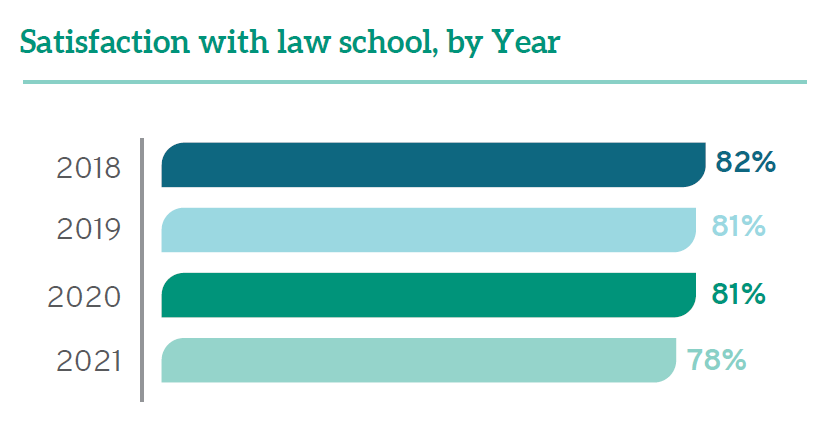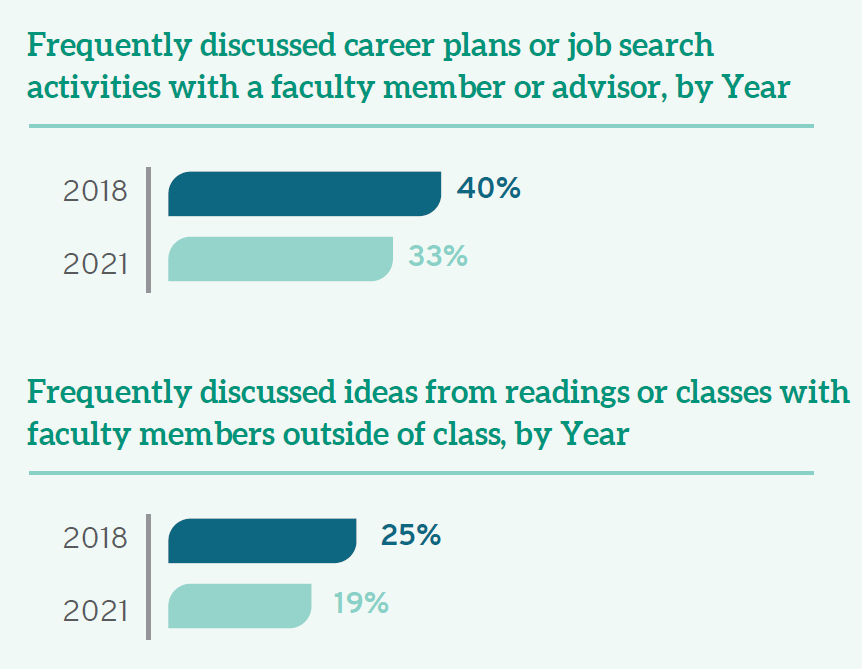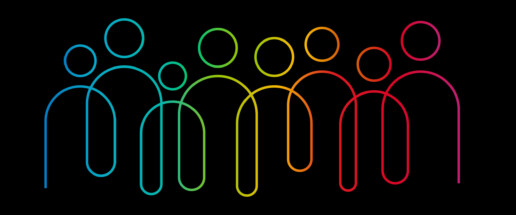Part 1: The COVID Crisis in Legal Education: Impact on Core Mission and Enriching Experiences
Because LSSSE has been annually administered since 2004, the survey was well-positioned to capture shifts in students’ perceptions and behaviors during the uniquely challenging 2020-2021 academic year. Our 2021 Annual Results, The COVID Crisis in Legal Education (pdf) draws from the core survey and two new modules (“Coping with COVID” and “Experiences with Online Learning”) to identify key struggles and successes of legal education during a period marked by uncertainty and disruption.
In the midst of a challenging year, some positives emerge from the data. Overall satisfaction remained high throughout legal education and comparable to past years. A full 78% of students in 2021 rated their entire educational experience in law school as “good” or “excellent,” which is similar to rates from recent years (82% in 2018, and 81% in 2019 and 2020). This is a testament to the significant efforts of faculty, staff, and administrators who pivoted to meet student needs as well as to the resiliency of the students themselves.

Nevertheless, the ability to forge and foster relationships has been especially difficult during the pandemic, which is borne out in the data. The percentage of students reporting positive relationships with staff dropped from 68% in 2018 to 59% in 2021—the lowest percentage recorded since LSSSE began collecting data on student-staff interactions in 2004. During those same years, positive student relationships with faculty and fellow students dropped just slightly from 76% to 72% and 76% to 73%, respectively. A full 93% of students appreciated that their law professors showed “care and concern for students” as the pandemic raged around them. First-year students were less likely to report positive relationships than 2Ls and 3Ls—likely because upper-class students could build on foundations they had cemented pre-COVID while 1Ls were attempting to start relationships from scratch in the midst of the pandemic.

The core of legal education remains relatively unchanged. Every year from 2018 to 2021, 85% of students have acknowledged that their schools contributed “quite a bit” or “very much” to their ability to acquire a broad legal education. There were also minimal changes this year compared to years past with regard to students developing legal research skills (80- 83%) and learning effectively on their own (81-82%).
Yet the intangibles of legal education were significantly affected by COVID-19, with potential negative consequences on the professional competency of these future lawyers. A full 90% of students noted that COVID interfered with their ability to participate in special learning opportunities, including study abroad, internships, and other field placements. While discussions about course assignments and faculty feedback on academic performance remained constant, just one-third (33%) of all law students found frequent occasions to talk with faculty members or other advisors about career plans or the job search process (down from 40% in 2018), and only 19% frequently discussed ideas from readings or classes with faculty members outside of class (down from 25% in 2018). There were also fewer opportunities for students to work with faculty members on activities other than coursework.

The COVID-19 pandemic has disrupted nearly all aspects of life, and law school is no exception. Although law schools did their best to continue on with the education of the next generation of lawyers, there were still marked decreases in student engagement, particularly in building relationships and gaining experience outside the classroom. In our next post, we will explore the areas in which law students struggled the most in their lives and show how the pandemic disproportionately impacted those students who were already the most vulnerable.
Guest Post: LGBTQ+ Inclusion: From Candidate to Law Student

LGBTQ+ Inclusion: From Candidate to Law Student
Elizabeth Bodamer, J.D., Ph.D.
Diversity, Equity, and Inclusion Policy & Research Analyst and Senior Program Manager
Law School Admission Council
When navigating the law school enrollment journey, LGBTQ+ candidates face the challenging task of meeting two important criteria: finding a law school that meets their academic and professional needs while also providing a culture that will support their full authentic selves both inside and outside of the classroom. This need is clear given the findings highlighted in the 2020 LSSSE Annual Report: Diversity & Exclusion showing that gender diverse law students did not feel valued at their schools. Additional findings using data from the 2020 LSSSE Diversity and Inclusiveness module reveal that gender diverse and LGBQ law students were more likely than cis-gender and straight students to report not feeling comfortable being themselves at their law schools (Figure 1).[1]
Figure 1: Students Reporting Not Feeling Comfortable Being Themselves

Source: Data from the 2020 Law School Survey of Student Engagement Diversity and Inclusiveness Module. Data collected from over 5,000 law students across 25 law schools. LGBQ students represented about 14% of the sample and gender diverse students represented 1% of the sample.
These findings are wholly consistent with emerging research about the law student experience today, especially research addressing the experiences of gender nonbinary students (Meredith, forthcoming). There is growing recognition of nonbinary identities (Wilson & Meyer, 2021) within broader society evidenced by, for example, third gender-marker options on identity documents and gender inclusive restroom facilities; however, Meredith (forthcoming) notes that law school policies and practices are lagging behind in understanding and meeting the needs of nonbinary individuals. Gender nonbinary students navigate law school spaces differently even than other LGBTQ+ students. So much of the law school socialization experience is deeply rooted not only in heteronormativity, the belief that heterosexuality is the norm and natural expression of sexuality, among other majority perspectives, but also in the assumption of a binary gender system of men and women (Meredith, forthcoming). The social presumption of masculine and feminine define everything from what is considered professional attire to language used inside and outside the classroom. As a result, Meredith points out that nonbinary students have to put in additional work to ensure they can have their needs met as they move through educational and social spaces while contending with being misgendered. This creates an additional, sometimes insurmountable barrier to success in law school for some that is completely unrelated to their academic ability.
Within this context and recognizing the changing landscape of legal education and life for LGBTQ+ individuals since LSAC first administered the LGBTQ+ Law School survey over 15 years ago, in 2020 the LSAC Sexual Orientation and Gender Identity subcommittee approved a new and robust candidate-centric survey. The specific purpose of the 2021 LSAC LGBTQ+ Law School Survey was to collect information on how law schools support LGBTQ+ students.[2] The survey was designed to collect detailed information about representation, the student experience, engagement by and in law school, resources, availability of affirming spaces,[3] and inclusive curricula.
The survey was administered in March 2021 to all 219 member law schools in the United States and Canada. A total of 136 U.S. law schools from 47 states and 5 Canadian law schools provided responses. In the coming weeks, LSAC will release an aggregate report, “LGBTQ+ Inclusion: From Candidate to Law Student,” that will offer a nuanced perspective on how law schools interact with and support LGBTQ+ students. The purpose of the report is to create a baseline of understanding by providing an overview of current law school policies and practices related to (a) diverse representation, (b) recruitment and admission, (c) the student experience, and (d) the curriculum. The results of this survey will have a number of immediate uses, including:
- Educating law school professionals about current LGBTQ+-related policies and practices in legal education in order to create a common understanding and baseline from which we can develop updates and advocate for inclusive and meaningful change.
- Developing strategic programming and resources for candidates and schools. This includes updating the LSAC LGBTQ+ Guide to Law School.
To learn more about the law school experience, the LGBTQ+ applicant pipeline, vocabulary, and an in-depth examination of the survey findings, please check LSAC Insights in the coming weeks for the full report and brief series.
References
Meredith, C. (Forthcoming 2021-2022) Neither Here Nor There. [Note] Indiana Journal of Law and Social Equality.
Wilson, B. D. M. & Meyer, I. H. (2021). Nonbinary LGBTQ Adults in the United States. Los Angeles: The Williams Institute.
__
[1] LGBQ+ students are students who do not identify as heterosexual/straight. Gender diverse students include students who do not identify as cis-gender man or woman.
[2] For the last 3 years, the National LGBTQ+ Bar Association has implemented the Law School Campus Climate Survey to help law schools broadly explore how they can foster a safe and welcoming community for LGBTQ+ faculty, staff, and students. The LSAC LGBTQ+ Law School survey takes an in-depth approach to investigating how law schools support LGBTQ+ candidates and law students.
[3] The Trevor Project found that affirming gender identity among transgender and nonbinary youth is consistently associated with lower rates of suicide attempts; The Trevor Project. (2019). National survey on LGBTQ youth mental health. The Trevor Project. https://www.thetrevorproject.org/survey-2020/.


